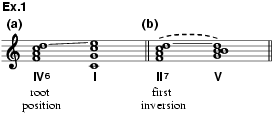(Fr. sixte ajouté).
In
functional harmony a subdominant chord with an added major 6th above the bass
(e.g. f–a–c'–d' in C major, f–a![]() –c'–d' in C minor); it can also be derived as the
first inversion of a 7th chord built on the supertonic. The ambivalent
construction of the added 6th chord engenders an ambivalence in the way it resolves,
as Rameau observed in the Génération harmonique (1737). If the chord is
viewed as an embellished subdominant triad, the added 6th must resolve upwards
to the 3rd of the tonic (ex.1a); if it is interpreted as an
inversion of II7, on the other hand, the added 6th is itself the
root of the chord and remains stationary in a resolution to the dominant (ex.1b).
–c'–d' in C minor); it can also be derived as the
first inversion of a 7th chord built on the supertonic. The ambivalent
construction of the added 6th chord engenders an ambivalence in the way it resolves,
as Rameau observed in the Génération harmonique (1737). If the chord is
viewed as an embellished subdominant triad, the added 6th must resolve upwards
to the 3rd of the tonic (ex.1a); if it is interpreted as an
inversion of II7, on the other hand, the added 6th is itself the
root of the chord and remains stationary in a resolution to the dominant (ex.1b).
